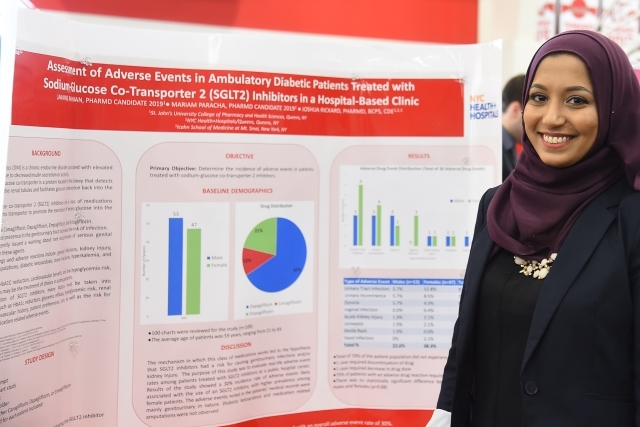
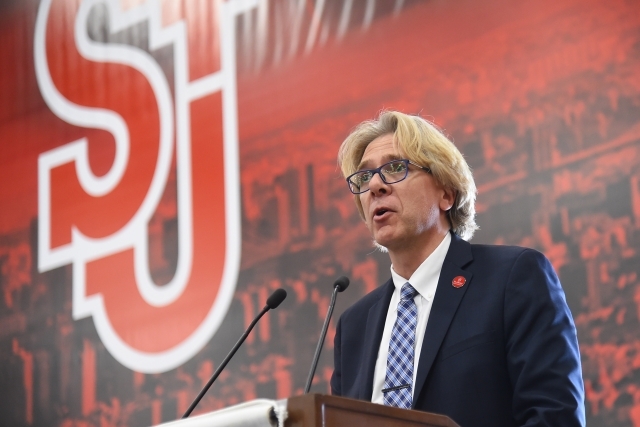
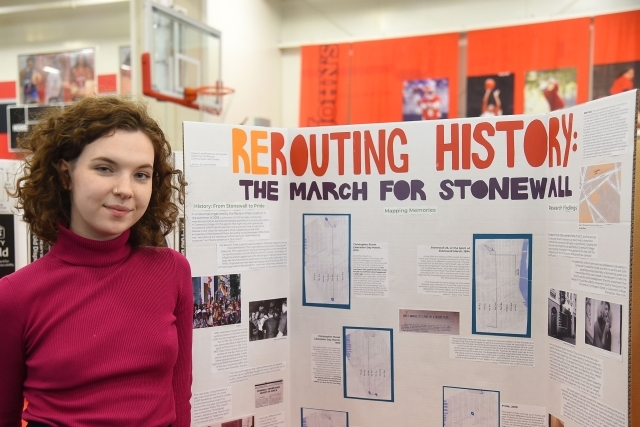
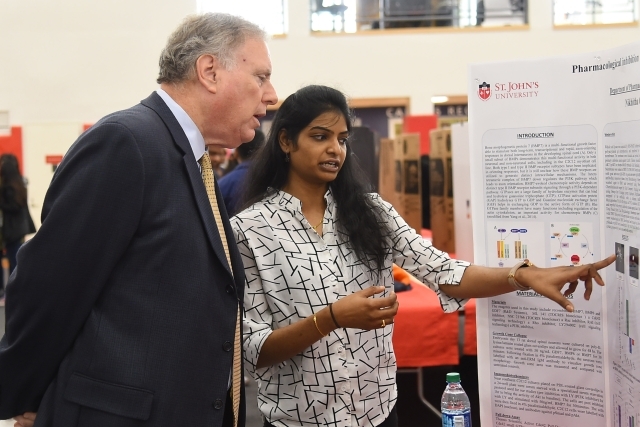
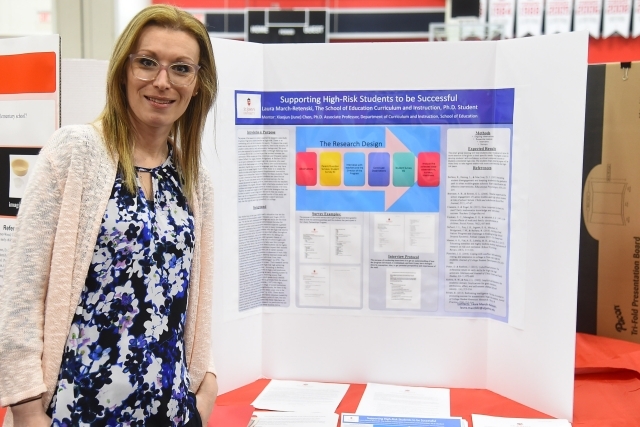
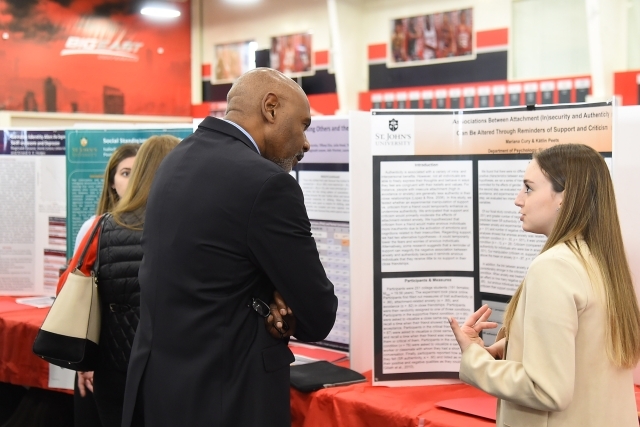
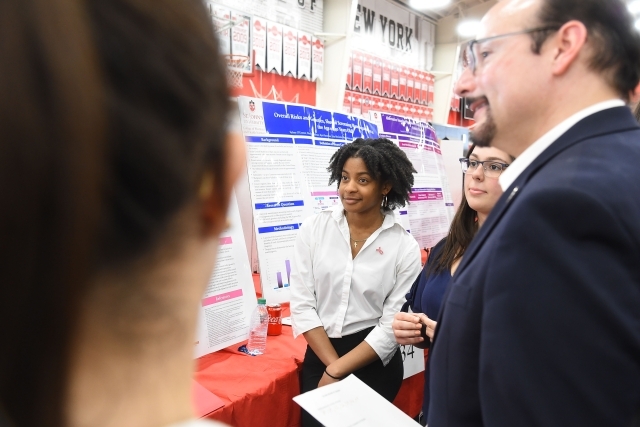
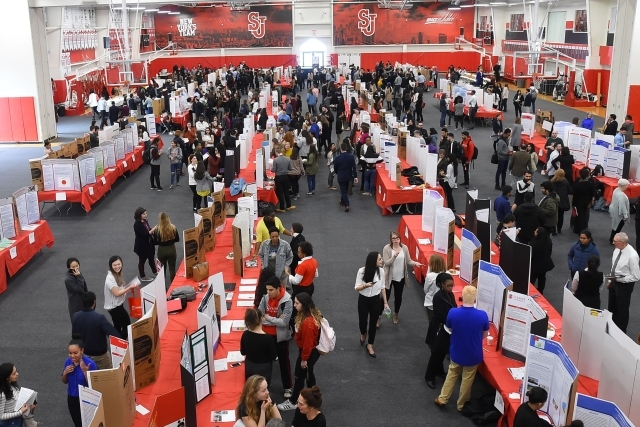
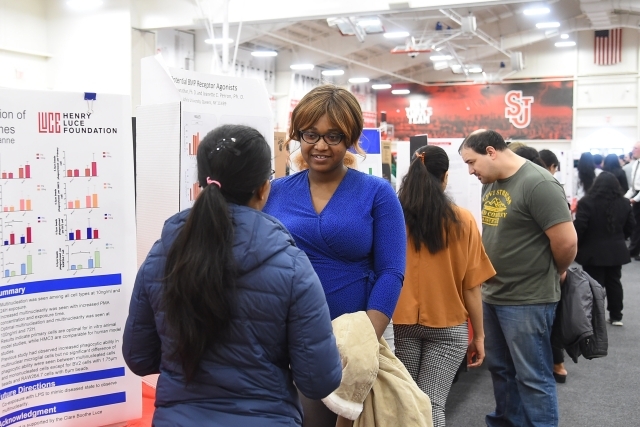
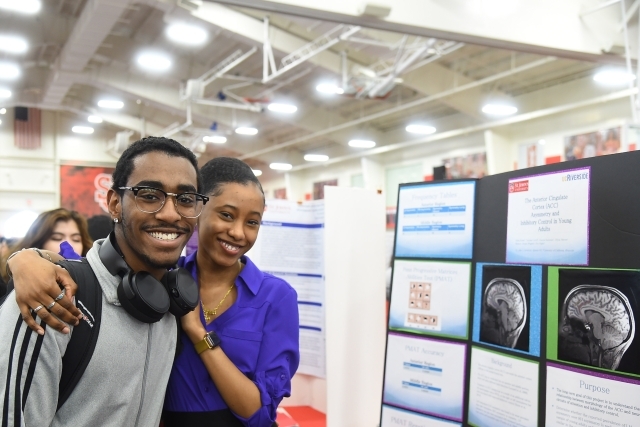
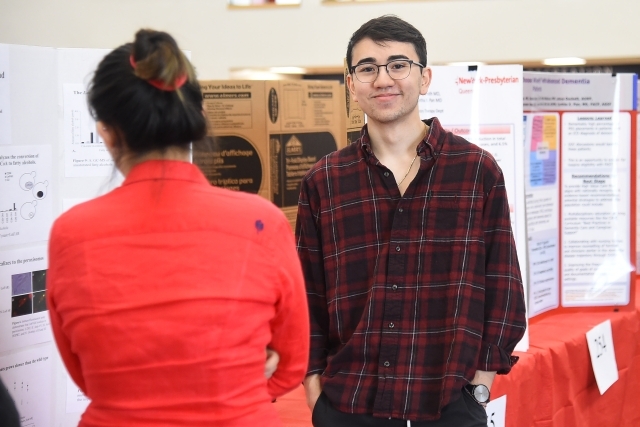
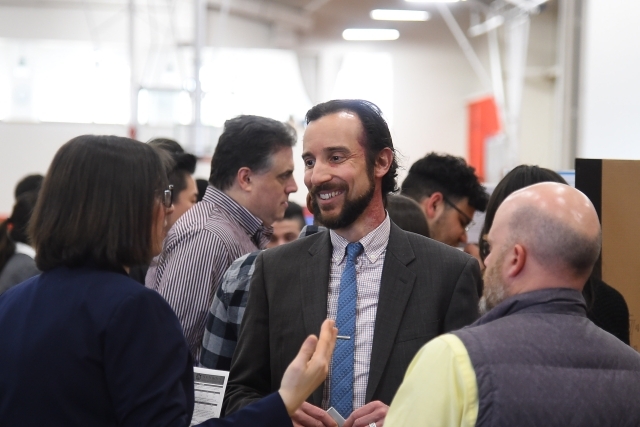
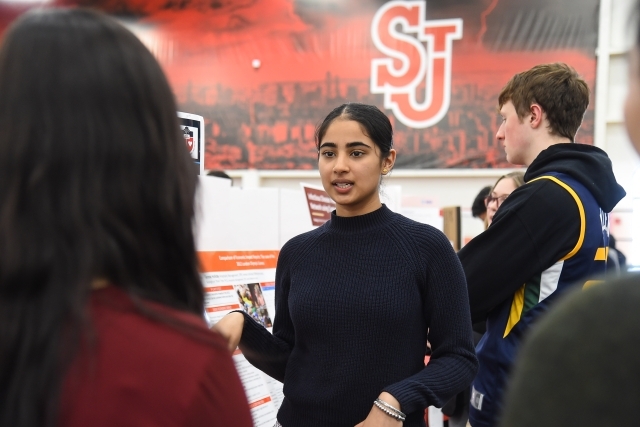
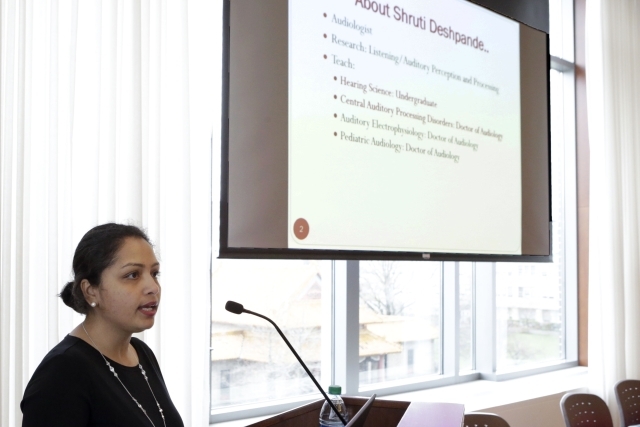
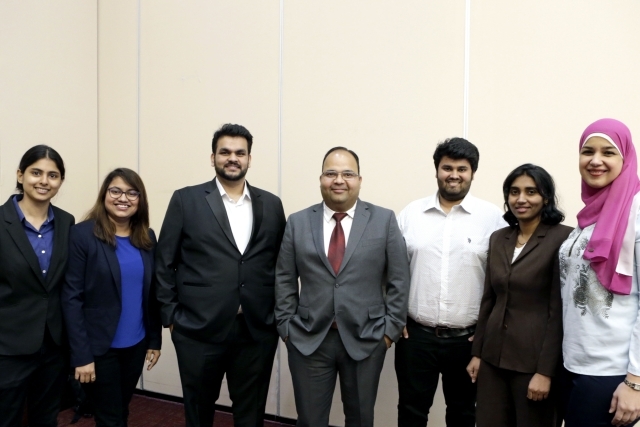
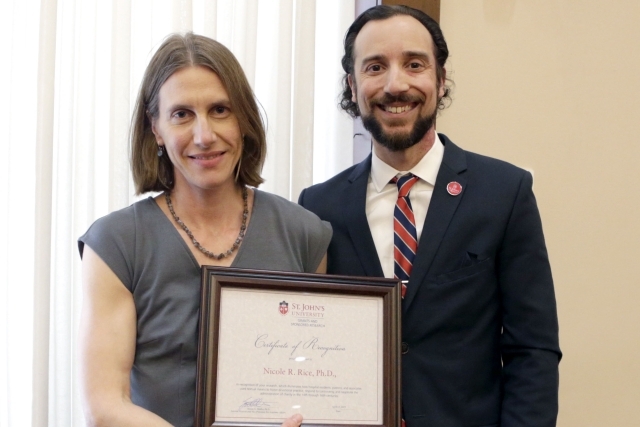
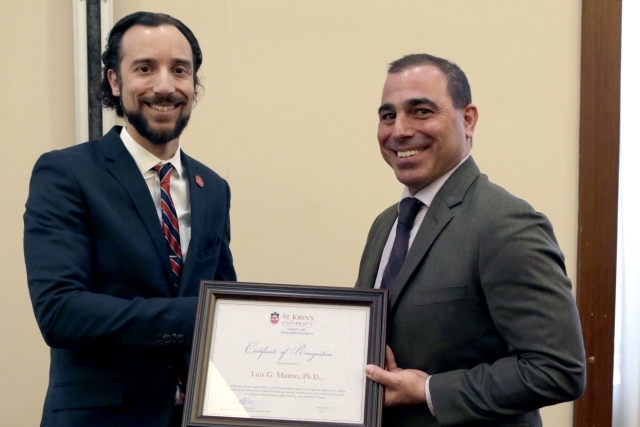
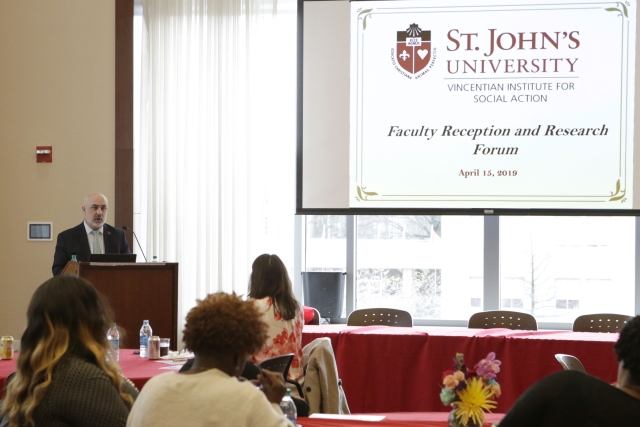
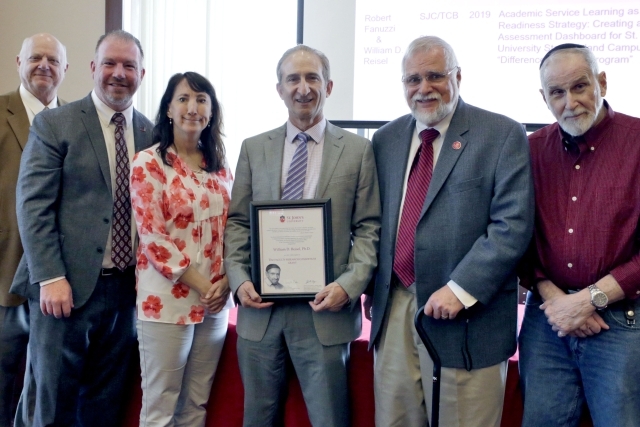
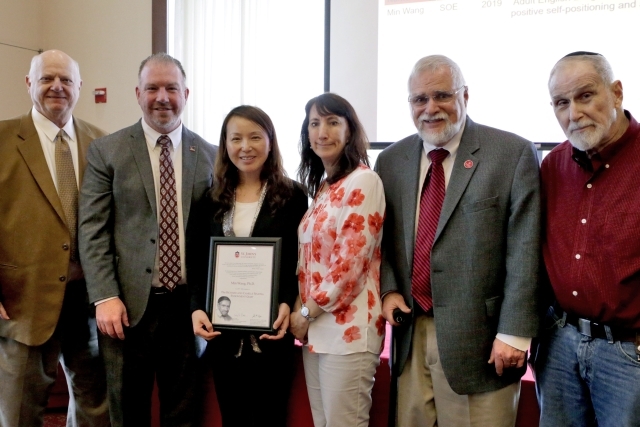
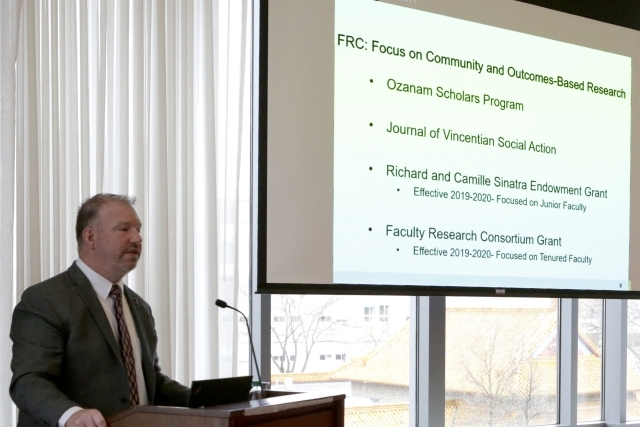





















A record-setting total of 550 students and faculty presented their scholarly research on Thursday, April 11, at a poster session on the Queens campus—one of the largest activities held during Research Month, hosted annually by St. John’s University.
There were 260 research posters on display, with student and faculty researchers on hand to explain their projects to their peers, as well as to a large crowd of visitors gathered inside Taffner Field House for the event. St. John’s Staten Island campus also held a poster session on Saturday, April 13, as part of Research Month activities at that location.
In welcoming remarks made during the poster session in Queens, Simon G. Møller, Ph.D., Interim Provost and Vice President for Academic Affairs, compared the number of posters this year to the 230 posters on exhibit during Research Month 2018, as well as the 208 posters submitted for the 2017 event.
“If we keep going at this rate, we may have to move future poster sessions over to Carnesecca Arena so that we have more room,” Dr. Møller jokingly said to his audience.
Research Month, which is traditionally held each April, provides the opportunity to showcase academic accomplishments among St. John’s students and professors and enables them to share research ideas and concepts with their classmates and colleagues.
“Great research takes a lot of time and hard work, but we do it because we aim to solve our global challenges. This is why research matters,” noted Dr. Møller. “The research being done at St. John’s is increasingly impressive and diverse. Our students present papers at national and international conferences, publications are thriving, and grant engagement continues to rise. We have much to celebrate.”
In addition to the poster session, Research Month features activities every year that include lectures, interdisciplinary roundtable discussions, receptions, luncheons to honor grant recipients, and workshops.
Each of the University’s schools and colleges were represented at the Queens poster session. In addition, the inclusion of 26 posters outlining research projects conducted at NewYork-Presbyterian Queens underscored its growing partnership with the University.
Student and faculty research projects covered an expansive array of topics, including the potential risks of radiology in cancer detection; human trafficking; infectious diseases; cultural identity through music; ocean pollution; racial and social injustices; politics; and the effects of acute exposure to lead.
Anthony Hubner, an adolescent education major, was very enthusiastic about the project he worked on with a team of students about human trafficking within the international chocolate industry.
“This is an issue close to my heart. Who doesn’t love chocolate?” asked Anthony. “But when you examine the issue of human trafficking, chocolate becomes very problematic because harvesting chocolate products often involves the forced labor of children. Big chocolate companies use people as capital, and we want to expose this occurrence more through our project.”
Alessandra Graci, who has a double major in sociology and history, exhibited her research on the Brownie camera. The Eastman Kodak Company developed the camera for the mass market in 1900 with a focus on children; it sold for $1 and transformed the availability of photography from the wealthy few to the general public.
“I wanted to track how the practice of snapshot photography became a critically important part of our culture,” Alessandra said. “Photography’s evolution as a chronicler for ordinary people—and as an art form—all stem from the Brownie camera, which no one today really knows about.”
“The experience of doing this work,” she said, “taught me how to put together a really fleshed-out piece of scholarship, find the proper resources, and do professional-level, accurate research.”
Biology major Amanda Chan teamed with students from St. John’s College of Pharmacy and Health Sciences to conduct a study of celastrol, a chemical compound from the root extract of Thunder God Vine, which is known for its antitumor and anti-inflammatory properties.
“This is the first time I did research at such a high level. Before this project, I did not know very much about what this kind of research entails,” Amanda said. “Now I am much more interested in conducting research as part of my career.”
The Staten Island campus also launched a very successful Research Month, according to Robert Fanuzzi, Ph.D., Associate Provost and Director of Civic Engagement at St. John’s Staten Island campus. “Research Month 2019 on the Staten Island campus attracted the largest number of student participants yet. Students were literally on the edge of their seats, listening intently to their fellow Johnnies give research presentations.”
“Our faculty members’ commitment to student participation means that we will expand venues for 2020,” Dr. Fanuzzi added. “But perhaps the greatest educational value of the month is this: students learning from students. With the help of Vincentian educational values, they are taking academic inquiries into essential and exciting directions. “
Social justice academic research by faculty was also on display during the Vincentian Institute for Social Action (VISA) Faculty Reception and Research Forum, another Research Month event, which took place on Monday, April 15, in the D’Angelo Center on the Queens campus.
VISA was created to provide faculty and students with an academic platform to address poverty and social justice issues. The forum was hosted by the Faculty Research Consortium (FRC) of VISA, a select group of interdisciplinary faculty members who demonstrate teaching, research, and scholarly expertise in areas related to community service, civic engagement, and social responsibility.
“The FRC is dedicated to promoting social justice research that aligns with the St. John’s University Vincentian mission to help those most in need,” said John M. Conry, Pharm.D., forum host, FRC Chair, Clinical Professor and Chair, Department of Clinical Health Professions, College of Pharmacy and Health Sciences. The FRC engages University faculty to promote this research through the Journal of Vincentian Social Action and two different grant opportunities.
Four faculty members were recognized during the forum as the 2019 recipients of these grants.
Min Wang, Ph.D., Assistant Professor, Education Specialties, The School of Education, received the Richard & Camille Sinatra Endowment Grant for her research on adult learners of the English language. The Sinatra grant supports community-based, outcomes research for full-time, junior, tenure-track faculty.
Smita Guha, Ph.D., Associate Professor, Department of Curriculum and Instruction, The School of Education, was awarded an FRC Grant for her work regarding health and nutrition for homeless mothers and children. The recently created grant supports community-based, outcomes research for full-time, tenured faculty at St. John’s.
Another FRC Grant was awarded to Dr. Fanuzzi. He shares the award with William D. Reisel, Ph.D., Professor, Department of Management, The Peter J. Tobin College of Business, for their research on academic service-learning as a college readiness strategy.
